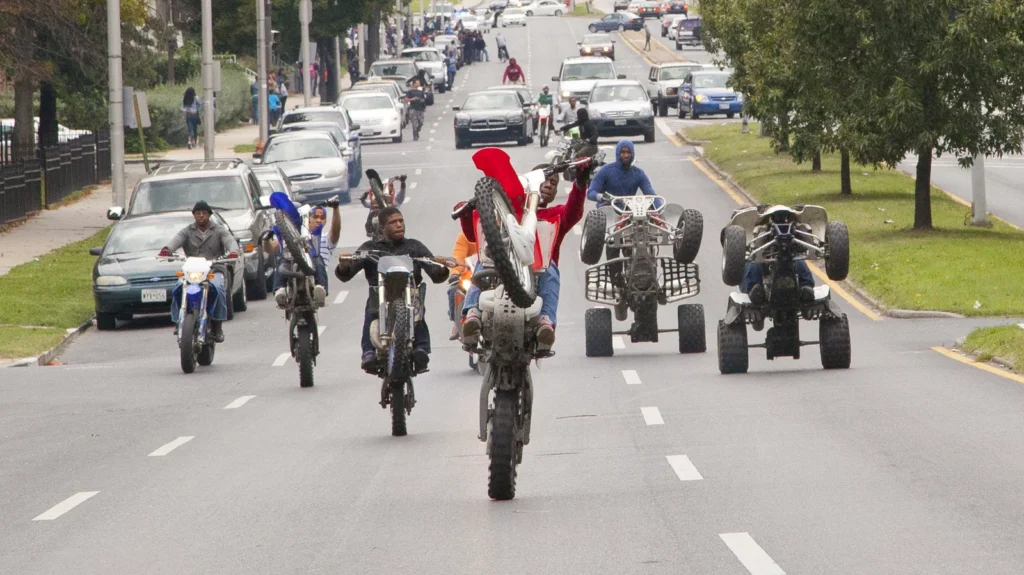There are moments in urban culture when time folds in on itself—when the past leaps forward, not as nostalgia but as reactivation. The biggest Baltimore ride-out of 2025, one that saw over 50 police officers and multiple helicopters deployed, was just such a moment. For a generation that came of age in the shadow of chopped dirt bikes and echoing two-stroke engines, this wasn’t just another flash ride. It was a resurrection. A sonic boom from a previous era, reminding the city of its ungovernable pulse.
For locals, especially those rooted in Baltimore’s long-standing bikelife culture, the ride-out wasn’t merely spectacle. It was memory, movement, rebellion—raw and unsanctioned. Wheelies climbed like prayers over pavement, chains rattled like war drums, and for a few volatile hours, the streets became something sacred again.
Long before it became a viral aesthetic or a cinematic shorthand for East Coast grit, Baltimore’s bikelife scene was a way of life. A blend of mechanical obsession, street choreography, and socio-political expression, the ride-outs have always signaled more than lawlessness. They were resistance and release in equal measure.
Bikelife in Baltimore dates back to the 1990s and early 2000s, when riders formed tight crews and customized their dirt bikes, four-wheelers, and pocket rockets. It wasn’t just about speed or stunts—though the wheelies and high-speed maneuvers grew more cinematic with time. It was about taking up space in a city that rarely gave young Black men that right freely. Streets became their stage, and engines their voices.
Despite being criminalized by law enforcement and often sensationalized in local news, the culture persisted. Documentaries, like “12 O’Clock Boys”, brought national attention to the scene. Even Meek Mill, in his earlier days, tapped into the symbolic power of the dirt bike as a tool of freedom.
Fast forward to 2025, and that ethos still burns—now stoked by a new generation with cameras, followers, and a hunger for authenticity.
This year’s massive ride-out wasn’t advertised with digital flyers or coordinated over apps. It moved the way real street energy does: whispered through blocks, passed from crew to crew, and captured in the ephemeral grammar of engine revs and tire screeches.
Riders gathered around key Baltimore hotspots: Druid Hill Park, North Avenue, Pulaski Highway. By mid-afternoon, hundreds of bikes poured into the streets—an unlicensed ballet of power, balance, and bravado. The cops knew something was coming, but they didn’t know how big.
Videos show stunt lines stretching across entire boulevards, packs of ATVs swerving in sync, wheelies running from traffic light to traffic light. Some riders wore ski masks, others were barefaced and grinning. There were no DJs, no wristbands, no stage. The only music came from engines harmonizing with cheers.
The footage feels like a throwback to 2009—grainy, chaotic, adrenaline-soaked. No polished edits or influencer polish. Just unfiltered bikelife: dirty chrome, gas smoke, and sweat.
As expected, the city responded. Within hours, Baltimore police had deployed over 50 officers, many in unmarked vehicles, and at least two helicopters to track and disperse the riders. But this wasn’t a scene that could be stopped by sirens.
Riders ducked down side alleys, disappeared into East Baltimore neighborhoods, reemerged across town in fluid waves. Arrests were minimal. Engagements were tense. One helicopter circled so low over North Patterson Park that dust swirled and car alarms rang out. Yet the energy didn’t falter. If anything, the police presence validated the riders’ message: you see us now.
The standoff between bikelife and law enforcement is nothing new. But in 2025, it feels more like performance art—a spectacle of state control met with grassroots rebellion. The visuals are stark: blue and red lights bouncing off gas tanks, tires leaving fresh rubber under surveillance beams.
Perhaps the most compelling aspect of this ride-out was its cross-generational texture. OGs from the early 2000s stood shoulder to shoulder with teens who learned to ride watching YouTube compilations. One scene shows a middle-aged man giving tips on clutch balance to a 16-year-old wearing Jordan 5s and a GoPro.
It’s a lineage of resistance—one passed through gasoline-stained gloves and shared routes. Unlike the fleeting TikTok trends that mimic rebellion, bikelife is inherited. And the ride-out reaffirmed this: the old heads haven’t left, they’ve just shifted to mentoring.
There was reverence here too. Some riders wore T-shirts honoring fallen comrades, with names and dates printed beside angel wings. The ride wasn’t just a flex. It was a memorial.
by news crews with telephoto lenses, but by citizen videographers, drones, bike-mounted GoPros, and even a few dashcams from supportive drivers.
The result is a visual archive of breathtaking intensity: shots of 20-deep wheelie trains, low-angle captures of riders flipping hand signals as they fly by, drone footage revealing the sheer scale of participation.
Some of these videos have already hit millions of views on YouTube and Instagram. But unlike the viral bikelife clips of yesteryear, these are narrativized. They include voiceovers, dates, locations. They function as street journalism.
In a world where truth is increasingly mediated by official channels, this kind of decentralized documentation becomes both art and evidence.
Baltimore has struggled for years to reconcile its stance on bikelife. Crackdowns have failed. Buyback programs fizzled. And “designated ride zones” never materialized.
Some progressive city council members have recently proposed a new idea: legal ride parks and cultural recognitionfor bikelife as a form of urban artistry. It’s controversial, but not without precedent. Cities like Philadelphia and Atlanta are exploring similar moves.
The ride-out puts pressure on these conversations. If the city cannot provide safe, sanctioned alternatives, it cannot reasonably expect the culture to vanish. Suppression only heightens spectacle.
What’s needed is dialogue, not drones. Infrastructure, not indictments.
To ride a wheelie through East Baltimore is not just to stunt. It is to resist gravity itself. It is a metaphor made physical—the act of lifting what should be grounded, of balancing chaos, of moving forward while everything tilts.
Writers from bell hooks to James Baldwin have explored the politics of movement. Bikelife belongs in this lineage. It is kinetic literature. It is motion that critiques stillness.
One rider put it best, mid-wheelie, captured on camera shouting: “This is church, shorty!”
Indeed. A congregation of velocity. A sermon in throttle.
The 2025 Baltimore ride-out was not just an event. It was a convergence—of culture, memory, rebellion, and futurism. It marked a return, but also an evolution. What began decades ago on cracked pavement with secondhand bikes has grown into a symbolic force capable of shaking the city’s very infrastructure.
For those who rode, filmed, or simply witnessed it, the message was clear: we are still here. Not waiting for permission. Not seeking acceptance. But claiming movement in a city that too often stands still.
And as long as there are engines to rev and streets to reclaim, Baltimore’s bikelife won’t fade. It will rise again. Wheelie after wheelie. Memory after memory.
Back like 2009. But built for now.
No comments yet.







